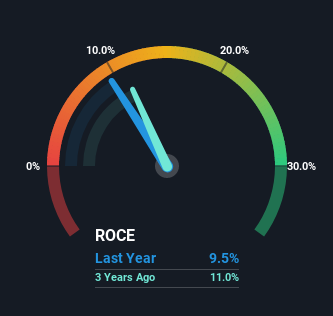- India
- /
- Infrastructure
- /
- NSEI:ADANIPORTS
Adani Ports and Special Economic Zone (NSE:ADANIPORTS) Is Reinvesting At Lower Rates Of Return

What trends should we look for it we want to identify stocks that can multiply in value over the long term? Firstly, we'll want to see a proven return on capital employed (ROCE) that is increasing, and secondly, an expanding base of capital employed. This shows us that it's a compounding machine, able to continually reinvest its earnings back into the business and generate higher returns. However, after briefly looking over the numbers, we don't think Adani Ports and Special Economic Zone (NSE:ADANIPORTS) has the makings of a multi-bagger going forward, but let's have a look at why that may be.
Return On Capital Employed (ROCE): What Is It?
Just to clarify if you're unsure, ROCE is a metric for evaluating how much pre-tax income (in percentage terms) a company earns on the capital invested in its business. The formula for this calculation on Adani Ports and Special Economic Zone is:
Return on Capital Employed = Earnings Before Interest and Tax (EBIT) ÷ (Total Assets - Current Liabilities)
0.095 = ₹86b ÷ (₹998b - ₹90b) (Based on the trailing twelve months to December 2022).
Thus, Adani Ports and Special Economic Zone has an ROCE of 9.5%. Even though it's in line with the industry average of 9.5%, it's still a low return by itself.
View our latest analysis for Adani Ports and Special Economic Zone

In the above chart we have measured Adani Ports and Special Economic Zone's prior ROCE against its prior performance, but the future is arguably more important. If you'd like, you can check out the forecasts from the analysts covering Adani Ports and Special Economic Zone here for free.
How Are Returns Trending?
When we looked at the ROCE trend at Adani Ports and Special Economic Zone, we didn't gain much confidence. Over the last five years, returns on capital have decreased to 9.5% from 14% five years ago. However, given capital employed and revenue have both increased it appears that the business is currently pursuing growth, at the consequence of short term returns. And if the increased capital generates additional returns, the business, and thus shareholders, will benefit in the long run.
What We Can Learn From Adani Ports and Special Economic Zone's ROCE
Even though returns on capital have fallen in the short term, we find it promising that revenue and capital employed have both increased for Adani Ports and Special Economic Zone. Furthermore the stock has climbed 76% over the last five years, it would appear that investors are upbeat about the future. So while investors seem to be recognizing these promising trends, we would look further into this stock to make sure the other metrics justify the positive view.
One final note, you should learn about the 4 warning signs we've spotted with Adani Ports and Special Economic Zone (including 1 which is significant) .
While Adani Ports and Special Economic Zone isn't earning the highest return, check out this free list of companies that are earning high returns on equity with solid balance sheets.
If you're looking to trade Adani Ports and Special Economic Zone, open an account with the lowest-cost platform trusted by professionals, Interactive Brokers.
With clients in over 200 countries and territories, and access to 160 markets, IBKR lets you trade stocks, options, futures, forex, bonds and funds from a single integrated account.
Enjoy no hidden fees, no account minimums, and FX conversion rates as low as 0.03%, far better than what most brokers offer.
Sponsored ContentNew: Manage All Your Stock Portfolios in One Place
We've created the ultimate portfolio companion for stock investors, and it's free.
• Connect an unlimited number of Portfolios and see your total in one currency
• Be alerted to new Warning Signs or Risks via email or mobile
• Track the Fair Value of your stocks
Have feedback on this article? Concerned about the content? Get in touch with us directly. Alternatively, email editorial-team (at) simplywallst.com.
This article by Simply Wall St is general in nature. We provide commentary based on historical data and analyst forecasts only using an unbiased methodology and our articles are not intended to be financial advice. It does not constitute a recommendation to buy or sell any stock, and does not take account of your objectives, or your financial situation. We aim to bring you long-term focused analysis driven by fundamental data. Note that our analysis may not factor in the latest price-sensitive company announcements or qualitative material. Simply Wall St has no position in any stocks mentioned.
About NSEI:ADANIPORTS
Adani Ports and Special Economic Zone
Operates and maintains port infrastructure facilities in India.
Solid track record with adequate balance sheet and pays a dividend.


